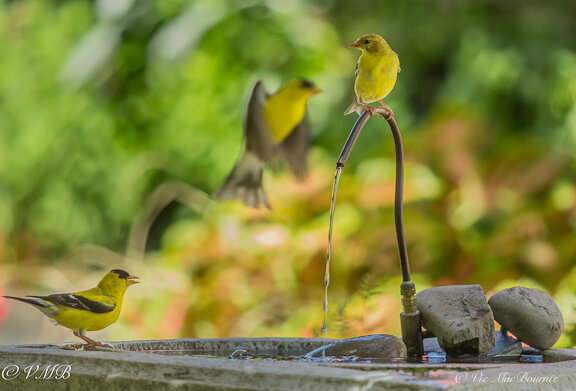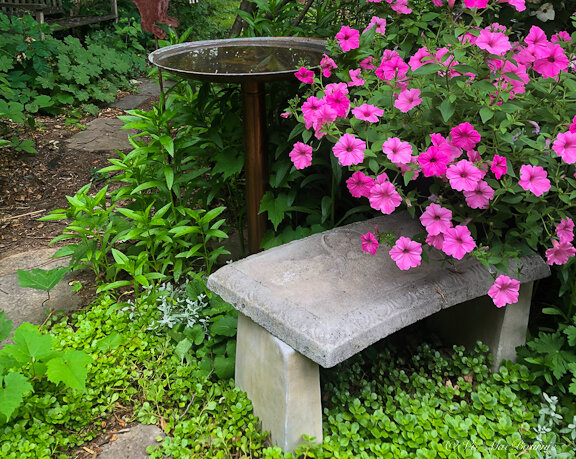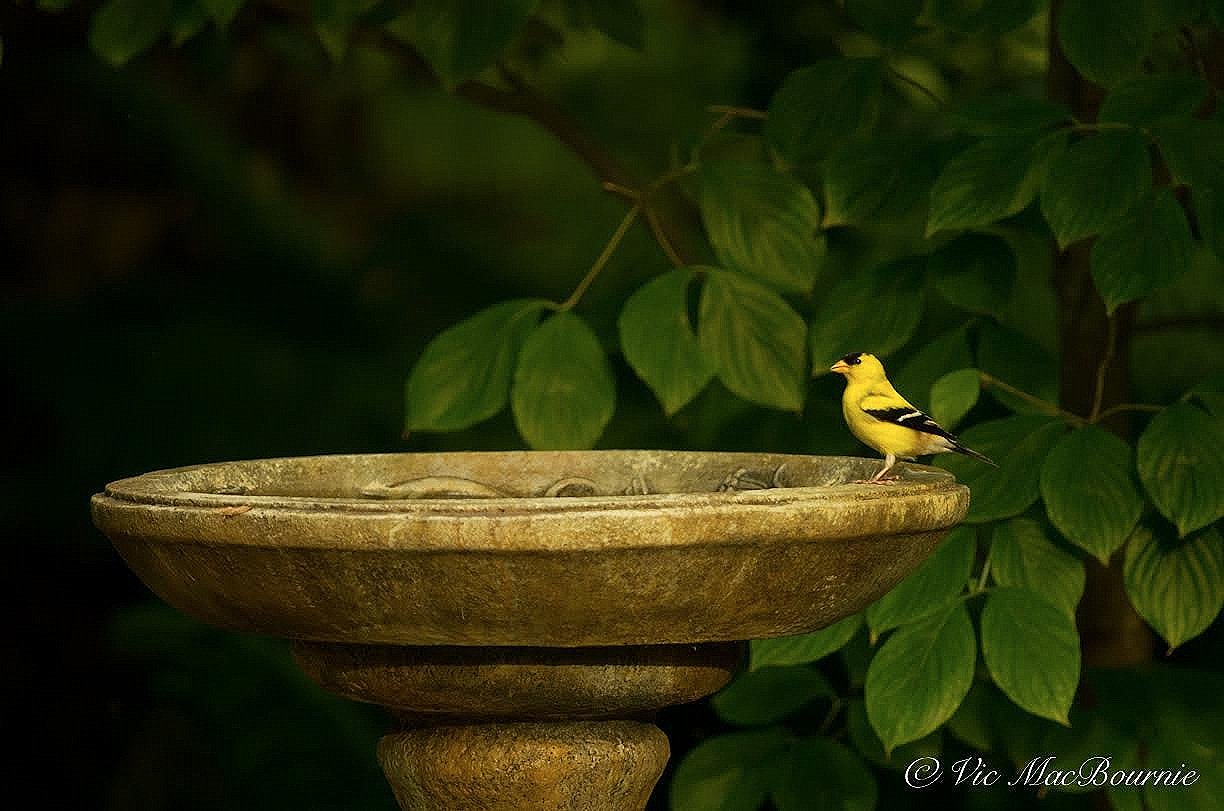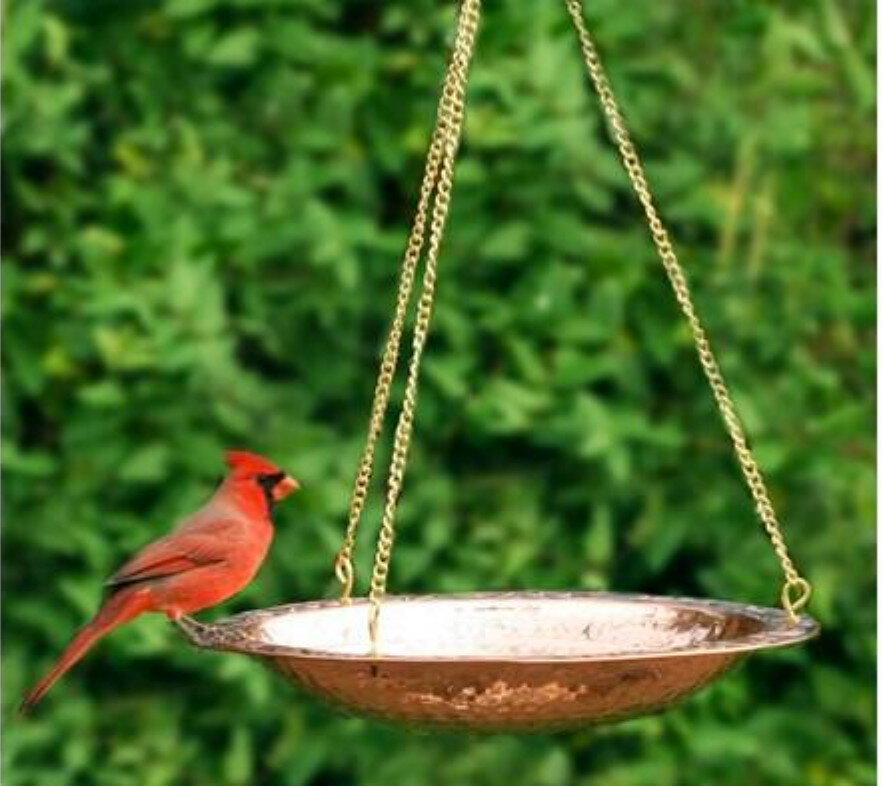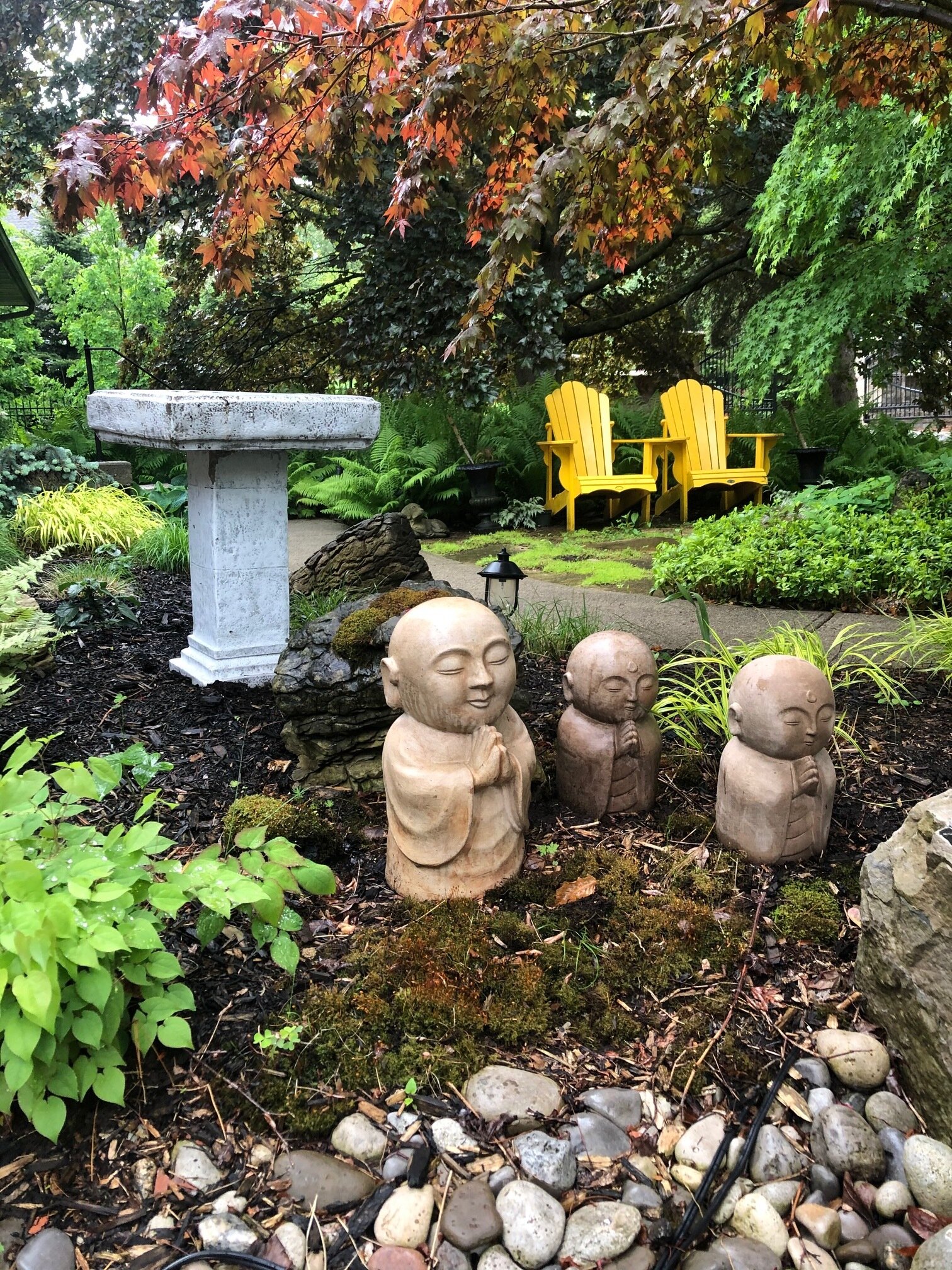What’s the best bird bath?
Goldfinches are attracted to the moving water from this DIY fountain.
What bird baths do birds use the most?
The best bird bath for your garden is the one the birds use the most.
It doesn’t have to be pretty, colourful, made of marble or have a three-tiered fountain.
In fact, it can be downright ugly. If the birds like it, then it’s the best for your woodland wildlife garden.
The question that really should be asked is: What bird bath do birds use the most?
The answer to that question is more complicated because birds, like we humans, are all different.
Having several very different bird baths at various levels will attract the largest number of birds to your backyard. This will not only attract a greater variety of birds, it will also limit territorial confrontations and ensure there is always a reliable water source in your garden. But, if I could have only one bird bath, it would be a very large concrete one raised a few feet off the ground, that has a rough surface for the birds to walk on, starts off quite shallow (a half inch) and gradually slopes toward the middle to about two to three inches deep.
I don’t own that bird bath. Instead, I offer the birds a multitude of above ground, hanging, and on-ground water sources of varying sizes where they can drink or bathe to their hearts’ content.
Provide birds with a choice of bird baths
In our front and back gardens, for example, there are usually between 10-12 bird baths on the go at any time during the spring, summer and fall. Most were purchased over the years either new from a store, purchased used from on-line marketplaces or home-made by yours truly.
A copper bird bath is always a good choice both for its aesthetics as well as its antimicrobial benefits.
All of them are very different and appeal to an ever changing variety of birds.
Some include running water. Others are very natural with rocks, pea gravel and moss. Most are concrete, but some are copper, fibreglass, plastic and ceramic. One is only for drinking water.
Do you need that many bird baths?
Absolutely not. But if you hope to attract a variety of birds, a few different bird baths placed strategically in your yard will be a major factor in meeting their varying needs.
If I could have only one bird bath, it would be a very large concrete one raised a few feet off the ground, that has a rough surface for the birds to walk on, starts quite shallow (1-inch) and gradually slopes toward the middle to about two to three inches deep.
Best bird baths for particular bird species
A look at the various bird baths in my garden and how the birds use them is a good way to establish the general hierarchy of backyard bird baths.
By examining how the birds use the various bird baths in my yard, readers can get valuable information about what type of bird baths might be best for their yards.
A favourite for our backyard birds
One of my favourite bird baths is a three-year-old concrete model that sits in a corner of the yard beneath a flowering dogwood and attracts probably the greatest number and variety of birds in our garden. I think its attractiveness to birds is as much about its location in the garden as it is about its construction, but more on locating a bird bath later in the article.
This bird bath has a rough surface to give birds confidence they will not slip. It has a 60-inch circumference and fairly steep sides leading to about a 2.5-inch-deep centre.
It’s not built for smaller birds who shy away from jumping into the depths of the bird bath.
The lip on the bird bath is wide and rough enough that smaller birds will not hesitate to land on it for a drink, but unless the water is quite low in the bird bath (often by the end of the day if used regularly that day) the smaller birds such as chickadees, goldfinches, nuthatches and small sparrows choose other bird baths in the garden.
This bird bath is particularly attractive to larger backyard birds including cardinals, Blue Jays, woodpeckers, thrushes and grackles that visit the bird bath daily both for drinking and bathing.
It’s also short enough that squirrels and chipmunks can jump up to it to get a quick drink if necessary.
Don’t be afraid to move bird baths to a new location
The location of this bird bath is also ideal. It’s in a 1/2 shade location that gets late afternoon and evening sun. It sits nicely right below a flowering dogwood that provides plenty of perching areas for the birds to work their way down to the water when they feel it is safe. There are no hiding places around it that would allow predators to stalk it easily and it’s also in a far corner of the yard that does not get a lot of human traffic.
It may not be possible to place your bird bath(s) in ideal conditions, but don’t hesitate to move bird baths around the yard to look for a spot where the birds feel especially comfortable using it.
Copper bird bath has antibacterial qualities
In another corner of the yard, close to the home, is a large copper bird bath purchased from a couple on Kijiji. The elegant copper bird bath proved too good to turn down despite a hefty price tag for a used bird bath and the hour-long drive to pick it up.
This is by far the largest of the traditional bird baths in our garden, with a 70-inch circumference and a middle depth of just over 2 inches.
It’s a popular choice for birds both big and small as well as a number of chipmunks and red squirrels who visit it regularly throughout the day.
Its close proximity to a garden seat and container planter gives the chipmunks and squirrels easy access to the bird bath that I can clearly see from the comfort of our family room.
The antibacterial qualities of copper is just an added bonus to its large water reservoir, gradual slope to the middle and it’s two-inch central depth. Its small rounded lip makes it easy for small birds to grasp for a quick drink and its depth is a favourite for our cardinals to use as their nightly bathing spot.
The copper bird bath’s biggest downfall is the fact that it, like any metal bird bath, can quickly overheat the water if left out in the sun for any given time. Even in the shade, the water can heat up on particularly hot days.
Our copper bird bath is in a shady area of the garden, but more importantly, it is very close to the hose and gets a cold-water top up on most days, especially on particularly hot ones.
Any metallic bird bath should be placed in a shady spot where it gets as little sun as possible to prevent the water from overheating.
A perfect solution is to purchase a copper hanging birdbath that you can tuck in a shady spot under a large tree, preferably near your favourite sitting area. This copper bird bath (see below) from Gardener’s Supply might be the perfect addition to your garden.
If your favourite place to watch the birds is on your deck, the deck mounted bird bath, also from Gardener’s Supply should do the trick.
This copper bird bath from Gardener’s Supply is ideal for hanging in a tree near your favouring sitting place.
Benefits of a copper bird bath
Copper’s malleability has made it a popular building material dating back close to 10,000 years where it has been used to make tools, eating utensils and other important household objects.
If a deck is your favourite hangout spot to watch birds, a copper birdbath that attaches directly to the deck makes not only enjoying the birds easy, but filling and cleaning the bird bath is simple too.
Today, whether in its pure state or combined with other metals to create alloys such as brass or bronze, it is primarily used to create decorative indoor and outdoor objects that age gracefully, especially in the garden where it takes on a beautiful patina over time.
Often overlooked is copper’s anti-algae and anti-bacteria qualities that make it the perfect choice for bird baths and bird feeders. Easy to clean, with its own limited self-sterilizing qualities, copper bird baths should get high marks when considering the purchase of a new bird bath. Their longevity, antibacterial qualities and natural good looks as they age in the garden makes them a fine investment if you are looking for both a piece of art and highly functional bird bath for your garden.
Although a copper bird bath seems like a perfect addition to any garden, besides the high purchase cost, they also tend to be quite light in comparison to a concrete or resin bird bath and as a result are easily damaged if they are knocked over onto a hard surface. When placing your bird bath, try to keep it away from a concrete pathway or patio where it would likely be damaged if it fell over or was knocked over.
If purchasing an expensive copper birdbath does not interest you, you can take advantage of the antibacterial qualities of copper by simply stripping copper wiring of its plastic sheathing, wrapping it around an object and placing it in the birdbath. Try tucking it under a couple of rocks to keep it hidden and stop any curious mammals or crows from carrying it off.
A rock placed in the bird bath gives smaller birds a safe and familiar landing place to drink from.
Add a solar fountain
I recently picked up two smaller copper-look bird baths on line that work well near our patio. I suspect they might have been for sale at a good price because the previous owners didn’t have much luck attracting birds with them.
At first glance they looked awfully deep and their steep, metal sides likely scared away any birds.
Perfect, I thought when I picked them up. A few modifications later, and our two very attractive bird baths would work well for both aesthetics and, more importantly, our backyard birds.
To solve the problem, a large rock was simply placed in the middle of the bird bath. The rock is large enough to protrude out of the water enough to give smaller birds a comfortable and safe landing spot to stop for a quick drink or dip into the bird bath.
The other bird bath was a perfect candidate for my DIY Solar drip turned fountain. Because the centre was so deep, I was able to bury the solar pump under the flat stone that is part of the drip. The combination works perfectly with the moving water attracting birds and the flat rocks giving them safe access to the water.
If you are looking to add a solar pump to a bird bath, it’s best to get a deeper one so the pump is in deep water even if the birds splash a fair amount of water out of the bird bath.
When birds think square is cool
Our square bird bath in the Japanese-inspired garden.
Let’s face it, everyone wants nice things in their garden.
If it can double as a piece of art, it’s even more valuable. That’s how I feel about our square, super heavy bird bath that graces our front Japanese-style garden.
It fits perfectly into the Japanese garden aesthetic with its simple straight lines, heavy square pedestal stand and equally heavy square top. The entire bird bath is painted white with an acrylic paint that gives it a sophisticated look rather than the rustic one often associated with traditional cement bird baths.
I love its looks, but more importantly, so do the birds – especially the Goldfinches that visit it daily on multiple occasions. But they are not alone, our neighbourhood Robins also have a soft spot for this bird bath as well.
Very different birds – one very large and aggressive while taking a bath, the other quite small and shy – attracted to the same bird bath.
What’s the story here?
It turns out that this bird bath has a huge square rim (3-inches wide) surrounding the round and rather deep centre pool (1.5- to 2.5-inches deep) that has a natural shallower spot in the middle. The robins hop right in and fully enjoy themselves in the deeper water, while the Goldfinches stay on the large brim and easily sip at the water’s edge. Small, decorative indentations (leaf motif) are often filled with water and allow the Goldfinches to sip from them in complete safety.
Other birds, especially Cardinals, also visit the Japanese-style bird bath that sits nicely in the shade under the perching branches of a mature Japanese Maple.
Nearby, is a massive boulder with a small natural pool in it that fills with water after a heavy rain. On my daily watering rounds, I always fill the small natural pool after filling the bird bath. The small pool is a favourite for small birds but it’s so small and shallow that it is not a reliable source of water. The nearby bird bath creates that all important reliable source of water for the birds.
Tiny concrete bird bath is a small-bird favourite
Since we are still in the front garden, let’s talk about the tiny concrete bird bath that has become a real favourite for small birds, and chipmunks winter, summer, spring and fall.
It’s been in the same spot for probably eight years, is a mere 1.5 inches-deep when it is brimming full (almost never) and measures only 22 inches in circumference. But the Goldfinches, Chipping sparrows, chickadees and chipmunks gravitate to it daily. In fact, keeping it full of water is almost a full-time job during the heat of the summer.
Why do birds like this bird bath so much?
The key to the success of the tiny bird bath is the fact that small birds feel extremely safe using it. It’s only about 14 inches off the ground, has a rough surface and is shallow enough that they can jump right in and get down and dirty (or should I say clean).
It’s surrounded by naturalistic gardens and sits in the shade of the canopy of three mature trees: A very large Crimson Maple, a good-sized Japanese Maple and a large single-trunk Serviceberry.
With good vision all around, little threat from above, and an abundance of quick escape hatches this bird bath has become a safe, quiet place that creates a comfort level that these small birds like to take advantage of whenever possible.
Two large, moss-covered limestone boulders provide both the birds and the chipmunks with a perfect place to preen after their baths. It’s not uncommon to see them taking turns flitting from the bird bath to the rocks and back again. Our front garden is also a quiet place, away from a lot of human activity making the bird bath even more desirable for shy birds.
On-ground water sources are a favourite
Ever seen a flock of birds having the time of their life in a puddle after a storm? It’s often a dirty puddle by the side of the road with a massive lake right next to it and they choose the puddle. Why?
It’s all about safety and easy access for these smaller birds.
And that’s the beauty of small, shallow on-ground water features sprinkled throughout the garden.
These water sources could be simple – an old lidless piece of tupperware – or more involved like concrete formed into a leaf pattern. Either way, the birds, mammals, amphibians and reptiles will thank you for providing much needed water at ground level where they have easy access to it.
Add a bubbling rock
A small, solar-powered bubbling rock is one of the most heavily used water sources in our woodland garden, but it’s not what you may think.
When I first installed the bubbling rock, I imagined birds flocking to the bubbling end sipping and splashing about and just having the time of their lives.
That didn’t really happen. Sure, on occasion a bird will perch on the rock and sip or frolic about in the bubbling end of the rock, but it’s more likely that the birds, chipmunks and squirrels drink from the water reservoir at the bottom of the bubbling rock.
It’s common knowledge that birds are attracted to moving water whether it’s a simple drip or the steady flow from a bubbling rock, but like anything, the reliability of that water is of prime importance. I believe that because the solar fountain is only on during sunny periods, the bubbling water is less reliable than the water in the reservoir and the birds and animals have gotten used to going to the reliable source.
Keep that in mind the next time you let your bird baths go dry for an extended period of time.
Nevertheless, between the reservoir and the bubbler, it’s a popular spot in our garden.
Concrete leaf and a moose’s ears prove popular
We fell in love with it the minute we saw it, paid too much for it, but have enjoyed it for years. A large rhubarb leaf molded into a concrete on-ground bird bath that needs to be filled daily and holds a tiny amount of water.
But I don’t know what the chipping sparrows would do these days without it. They are the leaf’s biggest fans in the bird world.
In the mammal world, the leaf has become a hangout for one of our friendly chipmunk families that decided the water-filled leaf made for the perfect backyard swimming pool going so far as to dig through and around large river rock and pea gravel to locate their back door right next to the leaf.
Living their best life among the soft sedum and rocky outcrop surrounding their backyard pool I guess.
In another area of the garden is Bruce (Springsteen) the moose with large ears that are actually quite deep water reservoirs. My fondest memory of Bruce the moose, was the time a mother Oriole brought her entire brood to bathe in Bruce’s oversized ears.
It was quite the sight.
The two ears act as water reservoirs. The ears are not big. In fact, the young Orioles had to take turns jumping into the ears, but once they got in they found the water quite deep (about 3 inches). No worries though. The tight confines ensured the little birds were not going to slip or fall over. Maybe that’s why mom brought them in to see Bruce.
Anyway, everyone had a great time playing in Bruce’s ears for about 10 minutes before flying off.
Hanging bird bath at home in a tree
If you are like me and like to watch the birds up close during your morning coffee, a hanging bird bath is the best option. Ours sits in a large yellow magnolia that actually overhangs our patio. In the mornings, the boisterous Carolina wrens and Chickadees use it for a quick morning bath or drink and I get to watch them between sips of coffee.
Our hanging bird bath is from Lee Valley and sports a very shallow (1-inch in the deepest part) ceramic bowl with a terra cotta edge to provide grip for the small birds. It needs regular filling, so placing it in a shady, easily accessible spot allows you to keep your eye on its water levels throughout the day.
Because it is so shallow, by placing a layer of pea gravel in it, butterflies, dragonflies and other insects may also become regular visitors.
In conclusion (not all bird baths are created equal)
Bird baths are no different than most things in life – a single solution is rarely the best.
Success will be more likely if you incorporate a few different bird baths to attract different types of birds. Large deep ones for big birds like Jays, Cardinals, Grackles, Orioles even the neighbourhood crows. Smaller, shallow birdbaths for Chickadees, goldfinches, nuthatches, sparrows, house and purple finches. On-ground bird baths for shy birds that prefer to bathe at ground level.
I have yet to mention our three massive garden water bowls that sit on the ground between 8-12 inches high. On more than a few occasions, I have seen a large hawk use one of the bowls as a bird bath.
Generally speaking the bigger and deeper the bird bath, the bigger the birds will be who use them.
A solar fountain is an excellent addition to any bird bath. Use one with a gentle spray nozzle to provide hummingbirds with an opportunity to cool off by flying through the spray.
Remember that bird baths don’t have to be expensive.
Birds aren’t looking for pretty. They are way to busy surviving.
Give them a helping hand and you’ll be rewarded ten times over.
Providing birds with water is vitally important, but don’t forget to provide food as well.
While I get great enjoyment from my bird feeding stations, providing natural food sources to our feathered friends is always the goal we should aspire to in our gardens. I have written a comprehensive post on feeding birds naturally. You can read about it here.
As an affiliate marketer with Amazon or other marketing companies, I earn money from qualifying purchases.

